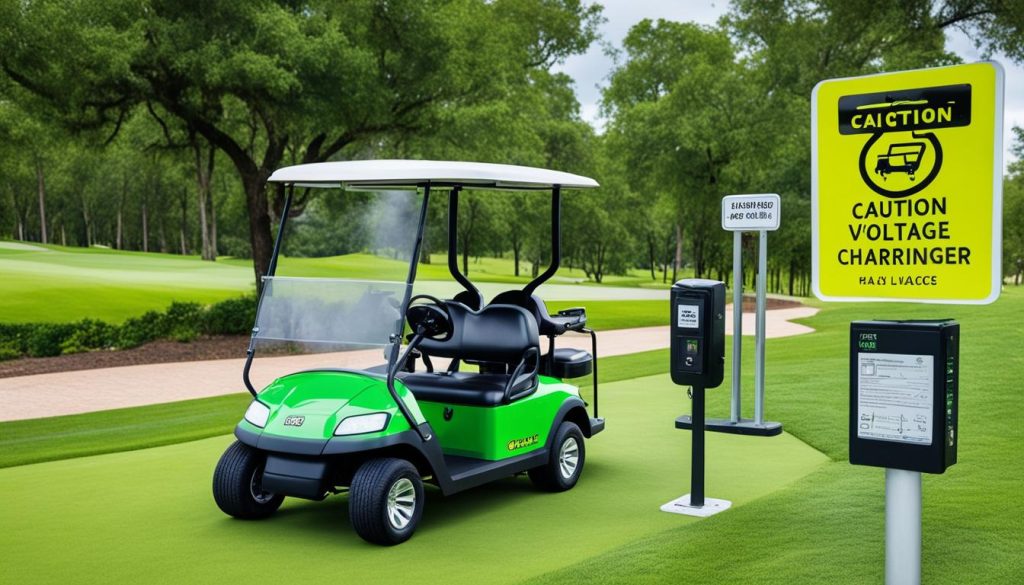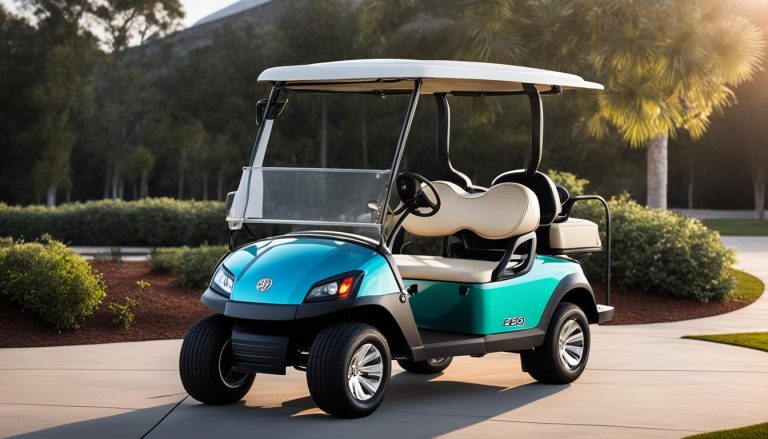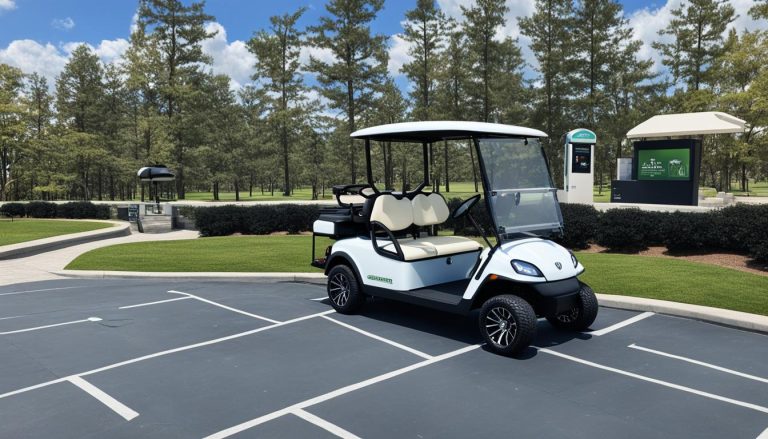Charge Your Golf Cart Battery Efficiently & Safely
batterychargers.site and its partners may earn a commission if you purchase a product through one of our links
Proper maintenance and charging are crucial for maximizing the performance and lifespan of your golf cart battery. If you own a golf cart, you already know how important it is to keep your battery in excellent condition. A well-maintained battery ensures that you can enjoy a smooth and uninterrupted ride on the golf course. In this section, we will discuss some essential tips and guidelines for charging your golf cart battery efficiently and safely.
Key Takeaways:
- Regular maintenance and charging are vital for your golf cart battery’s longevity and performance.
- Choose the best charger for your golf cart battery to ensure safe and efficient charging.
- Follow the recommended charging tips for optimal results, including fully charging the battery after each use and performing regular refresh charges.
- Proper maintenance, such as cleaning the battery and checking the connectors, is essential for battery health.
- Store your golf cart battery in a cool and dry location, fully charged, to maintain its performance during inactive periods.
Golf Cart Battery Maintenance Tips
Proper maintenance is essential for ensuring that your golf cart battery performs optimally and lasts longer. By following these maintenance tips, you can extend the lifespan of your golf cart batteries and maximize their efficiency:
- Charge the batteries fully after each use: Always charge your batteries to their full capacity after each round of golf or use. This helps to prevent the batteries from going into a low state of charge, which can reduce their overall performance.
- Use a proper style of golf cart battery charger: Invest in a high-quality golf cart battery charger that is specifically designed for your battery type. Using a matched voltage charger ensures that the batteries are charged correctly, prolonging their lifespan.
- Clean the batteries regularly: Regularly clean the batteries to remove any dirt, debris, or corrosive substances that may accumulate on the battery surface. Use a mixture of water and baking soda to clean the battery terminals and connectors.
- Check and tighten the battery connectors: Inspect the battery connectors periodically to ensure that they are tight and secure. Loose or corroded connectors can disrupt the flow of electricity and reduce the battery’s performance.
- Monitor the water levels and watering batteries: For golf cart batteries that require maintenance, such as flooded lead-acid batteries, regularly check the water levels and add distilled water as needed. Proper watering ensures that the internal components of the batteries stay submerged and allows for efficient operation.
Following these maintenance tips will help keep your golf cart batteries in excellent condition, ensuring longer battery life and reliable performance on the golf course.
“Good battery maintenance is the key to extending the life of your golf cart battery pack system.”
Charging Golf Cart Batteries Properly
To charge your golf cart batteries properly, follow these recommendations:
- Charge overnight: It is best to charge your golf cart batteries overnight to ensure a full charge and maximize their capacity. Charging them for the recommended period will help maintain their optimal performance. (SEO keyword: charge overnight)
- Use a matched voltage charger: Always use a charger that matches the voltage requirements of your golf cart batteries. Using an incompatible charger can result in undercharging or overcharging, which can significantly impact battery life and performance. (SEO keyword: matched voltage charger)
- Fully charge the battery: After each use, make sure to fully charge the battery. Partial charging can lead to decreased battery capacity and a shorter lifespan. (SEO keyword: fully charging the battery)
- Perform a refresh charge: Every 45 to 60 days, it is recommended to perform a refresh charge on your golf cart batteries. This helps eliminate any memory effect and maintains their capacity. In hot climates, refreshing the charge more frequently may be necessary. (SEO keyword: refresh charge)
- Monitor battery charging time: Keep track of the time it takes to charge your batteries fully. If it seems to take significantly longer than usual, it may indicate a problem with the batteries or charger that requires further investigation. (SEO keyword: battery charging time)
- Avoid excessive discharge: Do not let your golf cart batteries discharge completely before recharging them. Excessive discharging can damage the battery and reduce its overall lifespan. (SEO keyword: discharging batteries)
- Monitor battery voltage: Regularly check the battery voltage to ensure it is within the recommended range. Voltage levels can provide valuable insights into the condition of the batteries and help to detect any potential issues early on. (SEO keyword: battery voltage)
By following these charging practices, you can extend the battery life and ensure optimal performance for your golf cart batteries.

Comparison of Charging Practices
| Proper Charging Practices | Improper Charging Practices | |
|---|---|---|
| Charging Method | Charge overnight with a matched voltage charger | Use an incompatible charger or charge for short durations |
| Battery Performance | Maintains capacity and extends battery life | Reduces capacity and shortens battery lifespan |
| Refresh Charge | Perform every 45 to 60 days | Neglect performing refresh charges |
| Discharge Level | Avoid excessive discharge | Fully discharge the batteries before recharging |
| Battery Voltage | Regularly monitor voltage levels | Ignore voltage levels and potential issues |
Storing and Inactive Periods
When it comes to storing your golf cart battery, proper care is crucial to preserve its performance and longevity. Following the right steps before storing it can help ensure that the battery remains in optimal condition for future use.
Before storing your golf cart battery, it’s important to fully charge it. This step helps prevent any potential damage that may occur during storage and ensures that the battery is ready to use when you need it again. To achieve a full charge, use a suitable golf cart battery charger and allow the battery to charge completely.
Find a cool and dry location to store your golf cart battery. Extreme temperatures can negatively impact the battery’s performance and capacity. Therefore, it’s crucial to avoid exposing the battery to freezing temperatures or direct heat. Instead, choose a spot where the battery can remain in a stable and moderate climate.
To maintain the battery’s health while in storage, it’s recommended to perform a boost charge when the battery’s charge drops below 70%. A boost charge replenishes the lost capacity and ensures that the battery retains its optimal performance over extended periods of inactivity.
“Proper battery storage is key to preserving its efficiency and lifespan. Charge your golf cart battery fully before storing it in a cool and dry location. Avoid freezing temperatures or direct heat exposure. Inactivity periods can adversely affect the battery, so perform a boost charge when necessary to maintain its health.”
Regularly monitor the battery voltage to ensure it remains within the desired range. Voltage readings will help you determine if the battery needs any maintenance or charging while in storage. By keeping an eye on the battery voltage, you can address any potential issues promptly.
In conclusion, taking proper care of your golf cart battery during periods of inactivity is essential for its long-term performance. By charging it fully, storing it in a cool and dry location, performing boost charges when needed, and monitoring the battery voltage, you can extend its lifespan and ensure it is always ready for your next golfing adventure.

Avoiding Common Charging Mistakes
Proper charging practices are crucial for maintaining the longevity and performance of your golf cart battery. By avoiding common charging mistakes, you can ensure optimal battery health and extend its lifespan. Here are some important factors to consider:
- Overcharging golf cart batteries: Overcharging can lead to excessive heat, battery water loss, and decreased battery life. Always follow the manufacturer’s recommendations for charging time and avoid leaving the battery connected to the charger for longer than necessary.
- Using an improper charger: Using a charger that is not specifically designed for golf cart batteries can cause damage and reduce battery life. Make sure to invest in a charger that is compatible with your battery type and voltage requirements.
- Freezing locations and direct heat exposure: Exposing your battery to freezing temperatures or direct heat can cause irreparable damage. Store your golf cart in a cool and dry location, away from extreme temperature fluctuations.
- Leaving accessories on: Leaving lights, radios, or other accessories on for an extended period while the cart is not in use can drain the battery. It is important to turn off all accessories when not needed to conserve battery power.
- Discharging batteries beyond 80%: Discharging your batteries below 80% regularly can cause irreversible damage and reduce battery life. Avoid fully discharging the batteries if possible and recharge them before they reach a low state of charge.
- Charging lithium batteries: If your golf cart uses lithium batteries, it is crucial to follow the manufacturer’s recommended charging methods. Lithium batteries have different charging requirements and using the wrong charging methods can cause damage and safety hazards.
- Knowing when to replace the battery: Understanding the appropriate time for battery replacement is essential for maintaining optimal performance. If you notice a significant decrease in battery capacity or if the battery fails to hold a charge, it may be time to consider a battery replacement.
By avoiding these common charging mistakes and following proper battery maintenance practices, you can maximize the lifespan and performance of your golf cart battery.
“Proper charging practices are crucial for maintaining the longevity and performance of your golf cart battery.”
Charging Lead-Acid and Lithium-Ion Batteries
Charging lead-acid and lithium-ion batteries requires different approaches. Understanding the specific requirements for each battery type is essential to ensure optimal performance and longevity.
Lead-Acid Battery Charging
Lead-acid batteries, such as deep cycle lead-acid batteries commonly used in golf carts, rely on maintaining electrolyte levels to function effectively. When charging a lead-acid battery, there are several important steps to follow:
- Check Voltage Settings: Before charging, ensure that the voltage settings of the charger match the battery’s specifications. Incorrect voltage settings can lead to overcharging or undercharging, which can shorten the battery’s lifespan.
- Monitor Water Levels: Lead-acid batteries require regular monitoring of water levels. Low water levels can result in reduced battery performance and potential damage. Add distilled water as needed to maintain optimal electrolyte levels.
- Charging Process: Connect the charger to the battery and follow the manufacturer’s instructions for the appropriate charging process. This typically involves setting the charger to the desired charging mode, which may include bulk charging, absorption charging, and float charging stages.
Lithium-Ion Battery Charging
Lithium-ion batteries have become increasingly popular due to their small size, high energy density, and fast charging capabilities. When charging a lithium-ion battery in your golf cart, consider the following:
- Follow Instructions: Always follow the manufacturer’s instructions for charging a lithium-ion battery. Each battery may have specific requirements, including charging voltage, current, and temperature restrictions.
- Temperature Considerations: Charging a lithium-ion battery at extreme temperatures can negatively impact its performance and lifespan. Avoid charging in excessively hot or cold environments.
- Battery Saturation: Lithium-ion batteries have a critical saturation point that ensures optimal function. It is important to allow the battery to reach this saturation point during the charging process.
Remember, whether you have a lead-acid or lithium-ion battery in your golf cart, it is crucial to follow the appropriate charging process to maximize battery life and performance. Additionally, regular maintenance, such as checking voltage settings, monitoring water levels, and considering battery replacement when necessary, will help ensure optimal battery operation.
| Charging Aspect | Lead-Acid Batteries | Lithium-Ion Batteries |
|---|---|---|
| Ideal Charging Process | Check voltage settings, monitor water levels, follow multi-stage charging process | Follow manufacturer’s instructions, consider temperature restrictions, ensure battery reaches saturation point |
| Ion Production | Dependent on electrolyte levels | Chemical reaction within the battery |
| Charging Time | Longer charging time compared to lithium-ion batteries | Faster charging due to high energy density |
| Battery Replacement | Regular monitoring, check for signs of aging or reduced performance | Consider battery life cycle and performance deterioration |
When to Replace Your Golf Cart Battery
Knowing when to replace your golf cart battery is crucial for avoiding unexpected issues while out on the course. Battery age and signs of failure are key indicators that it may be time for a replacement. By assessing the health of your battery, you can ensure optimal performance and avoid any disruptions during your game.
One way to evaluate the condition of your battery is by considering its age. On average, golf cart batteries have a lifespan of around 4-6 years, depending on usage and maintenance. If your battery is approaching or exceeding this age range, it may be time to start considering a replacement to avoid any potential issues in the near future.
In addition to age, there are signs of battery failure that you should watch out for. These include a significant decrease in performance, such as reduced driving range and power. If you notice that your golf cart is not holding a charge as well as it used to or that it requires frequent recharging, it could be a sign that the battery is failing and needs to be replaced.
To accurately assess your battery’s health, you can use tools like a battery hydrometer for lead-acid batteries. This device measures the specific gravity of the battery’s electrolyte, which can indicate its overall health and capacity. If the specific gravity readings are consistently low, it may be a clear indication that your battery is failing and should be replaced.
When the time comes for a replacement, proper battery installation and maintenance are essential for ensuring optimal performance. Follow the manufacturer’s instructions for installing the new battery and make sure it is securely connected. Regular maintenance, such as cleaning the terminals and checking the water levels (if applicable), will help extend the lifespan of your new battery and keep it in good health.
FAQ
How often should I charge my golf cart battery?
It is recommended to fully charge your golf cart battery after each use to ensure its optimal performance and longevity.
What type of charger should I use for my golf cart battery?
To charge your golf cart battery effectively, use a matched voltage charger that is specifically designed for golf cart batteries. This will ensure safe and efficient charging.
How should I clean my golf cart battery?
Regularly cleaning your golf cart battery is important for its maintenance. Use a mixture of baking soda and water to clean the battery terminals and connectors. Rinse them with clean water afterward and ensure they are dry before reconnecting.
Why is it important to monitor the water levels in my golf cart battery?
Monitoring the water levels in your golf cart battery is important to prevent them from drying out. Dry batteries can lead to reduced performance and can be damaged. Therefore, it is crucial to check the water levels regularly and add distilled water as needed.
How often should I water my golf cart battery?
The frequency of watering your golf cart battery depends on its usage and the climate conditions. Generally, you should check the water levels once a month and add distilled water when needed.
Can I overcharge my golf cart battery?
Yes, overcharging your golf cart battery can lead to damage and reduce its lifespan. It is important to follow the manufacturer’s instructions and avoid keeping the battery on charge for an extended period.
How long does it usually take to charge a golf cart battery?
The charging time for a golf cart battery can vary depending on its state of charge and the charger being used. It is recommended to charge the battery overnight to ensure a thorough and complete charge.
How can I avoid damaging my golf cart battery during storage?
To avoid damaging your golf cart battery during storage, fully charge it before storing it in a cool and dry location. It is also important to monitor the battery voltage and perform a boost charge when the charge drops below 70% to maintain its health.
What are the common charging mistakes I should avoid with my golf cart battery?
Common charging mistakes include overcharging the batteries, using an improper charger, exposing the batteries to freezing temperatures or direct heat, leaving accessories on for an extended period, discharging the batteries beyond 80%, and using improper charging methods for lithium batteries.
How do I know when it’s time to replace my golf cart battery?
To determine when it’s time to replace your golf cart battery, consider its age and signs of failure. Tools like a battery hydrometer can help evaluate the electrolyte gravity in lead-acid batteries. Proper battery installation and maintenance are essential for optimal performance when replacing the battery.






